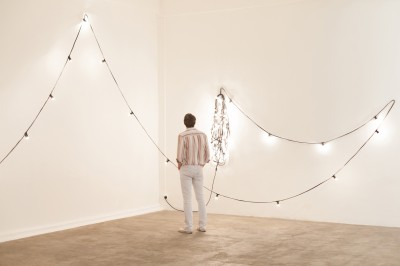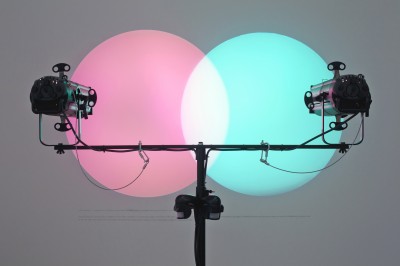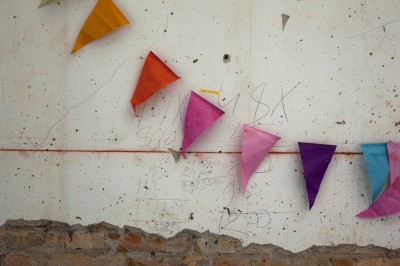Amalia Pica’s art enunciates at the MCA

Amalia Pica, Installation view, “Outside, inside and across.” Chisenhale Gallery, 2006/12. Collection of Andrew Ong and George Robertson. Photo: Mark Blower, courtesy of the artist; Herald St, London; Marc Foxx, Los Angeles.
“A picture is worth…”
This sentence should be easily completed; we should all know what comes next. But the work of Amalia Pica, exhibited at the MCA through August 11, puts this aphorism to test — finding it true in some instances, and horribly simple in others.
Engaging art and recent social history, Amalia Pica sets stages, literally in “Stage (as seen on Afghan Star)” and metaphorically, for a look at human behavior and varying forms of communication. Her subjects include conversation, listening, performing, reading and watching.

Amalia Pica, “Venn diagrams (under the spotlight),” 2011. Installation view, 54th Venice Biennale: ILLUMInations, 2011. Coleccion Patricia Phelps de Cisneros. Photo: Kiki Triantafyllou, courtesy of the artist; Herald St, London; Galerie Diana Stigter, Amsterdam; Marc Foxx Gallery, Los Angeles.
A thrift store menagerie of colorful glasses protruded butt-first from the gallery wall at the entrance of the exhibition, offered as hearing aids. The piece, “Eavesdropping (version #2),” isn’t as utilitarian as it sounds, unless you’re interested in hearing the soft whir of wires and pipes behind a freshly painted gallery wall, probably nothing scandalous.
Most of the pieces work in this way, as an impulse for communication, but not necessarily as operative. The work echoes post-minimalist and conceptualist forms, such as “Outside, inside and across,” which resembles Felix Gonzalez-Torres’ lightbulb installations, or the Post-It note imprint, “Post-It Note 2009-2010,” that points to Dennis Oppenheim’s “Reading Position for Second Degree Burn.” Pica’s work, however, is engaged in the discourse of civic participation and how we, as citizen subjects, attach to these forms of communication.

Amalia Pica, “Strangers,” 2008. Installation view, 54th Venice Biennale: ILLUMInations, 2011. Phot: Kiki Triantafyllou, courtesy of the artist; Herald St, London; Marc Foxx, Los Angeles; Diana Stigter, Amsterdam
Implicit in Pica’s work is a sense of fading festivities. “Outside, inside and across,” the aforementioned light bulb installation, “Stabile (with confetti) #2,” pieces of confetti scattered and then meticulously taped in place to the floor, and “Strangers, 2008,” a single string of rainbow bunting, are all the remnants of a celebration, one of the most engaging reasons to congregate.
Rather than discarding this debris, however, Pica secures these impermanent gestures, delaying their transitions into memory and curbing their mobility. She presents material traces of gestures of social attachment in order to mark the passage of time that so often leads to the dissolution of specific utterances. In all of her work, there is this focus on what we utilize, leave behind or overlook when forming bonds, always both intimate and political.
In this body of work, an image, a piece of debris or a stage replica is worth a lot to Pica. However, despite their ability to signal to moments of enunciation, one can’t help feeling that that moment and the attachments that it formed were worth just as much, if not more.





















